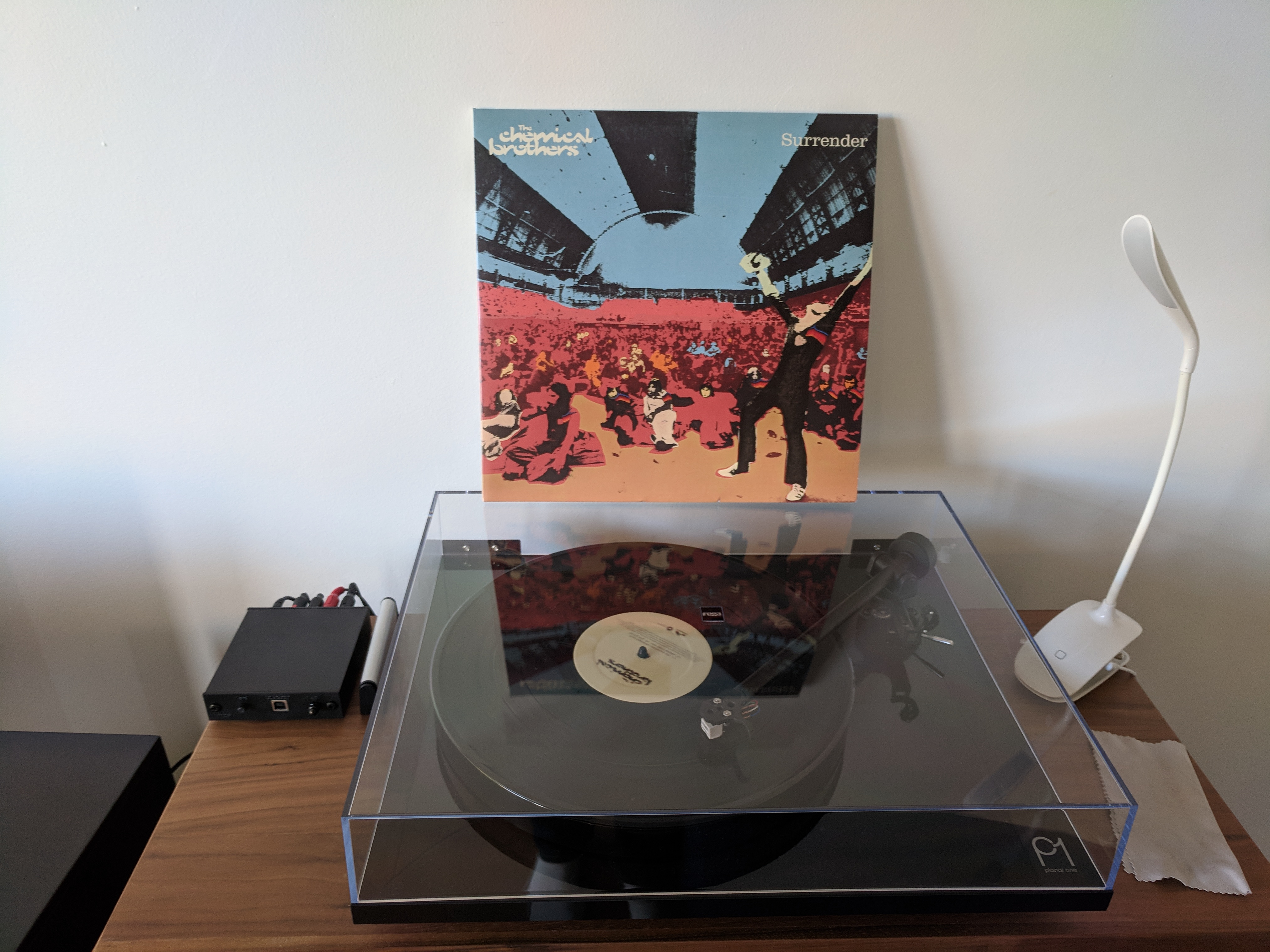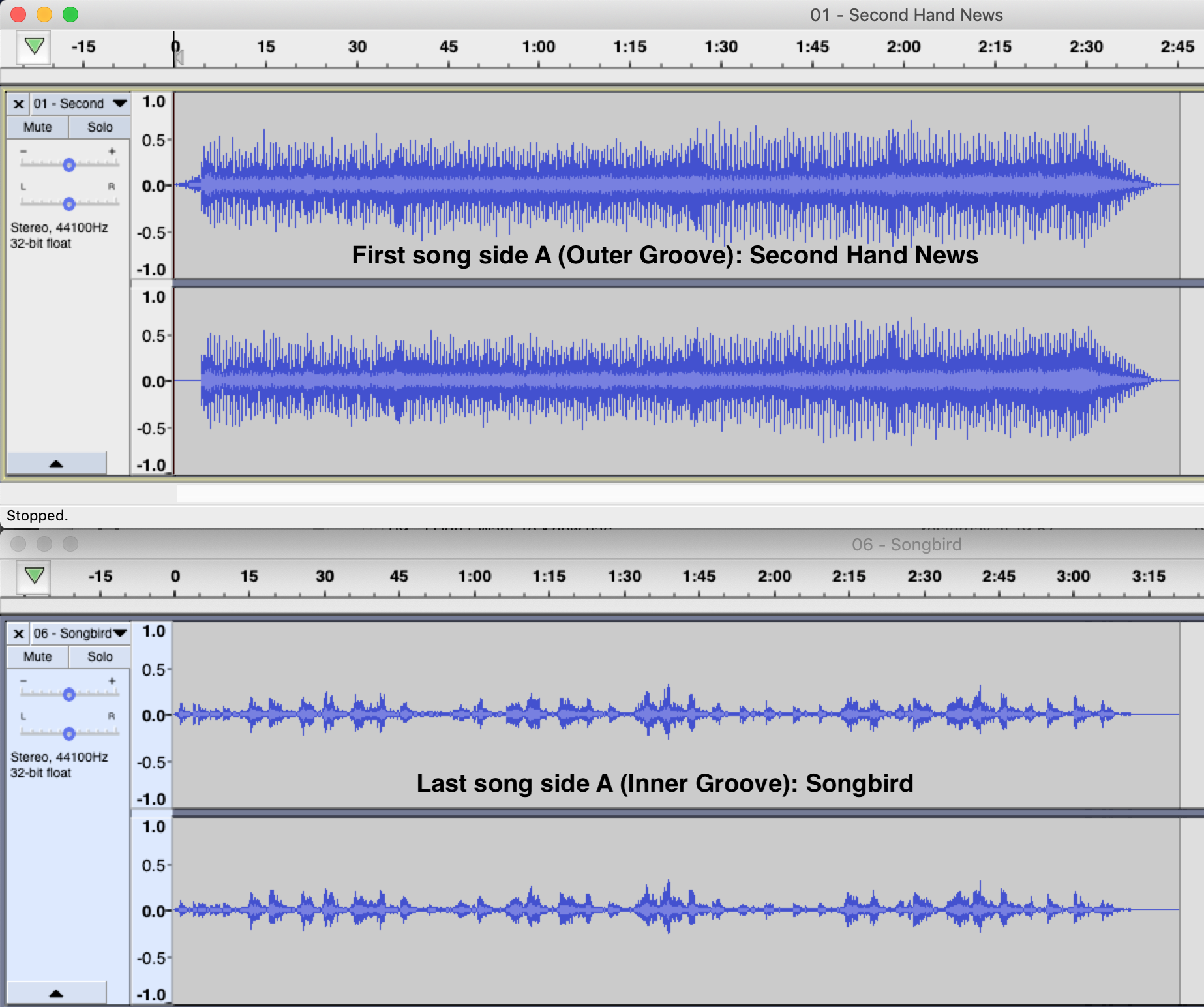I moved back to Australia in 2017 after living in the UK for eight years. I liked the idea of owning my favourite albums on vinyl. I finally had space for a hifi system and records.
Taking advice from a friend and brother, I bought a Rega Planar 1 turntable, Rega Fono Mini A2D preamp and Advanced Acoustic Air 55 active speakers. I love how records sound through my modest components.
In the past three years I have hunted down my favourite albums, upgraded my turntable’s components and learnt a lot in the process.
Records are a pain
The first thing to know is records are a pain.
They need to be cleaned. They can warp. They require homework before purchasing, because not all records sound good. Your turntable needs to be setup correctly: your cartridge needs to be properly aligned and weighted. Too little weight: your records will skip. Too much: your music will lose high frequencies. Your turntable needs to be level. You need accessories to keep your records and stylus clean. A microscope to inspect your stylus. A tracking-force gauge to ensure your cartridge is properly weighted. A level. Microfiber cloths and a cleaning solution for removing dust. Or another cleaning device which needs cleaning fluid. A stylus cleaner. Records are heavy and take up space.
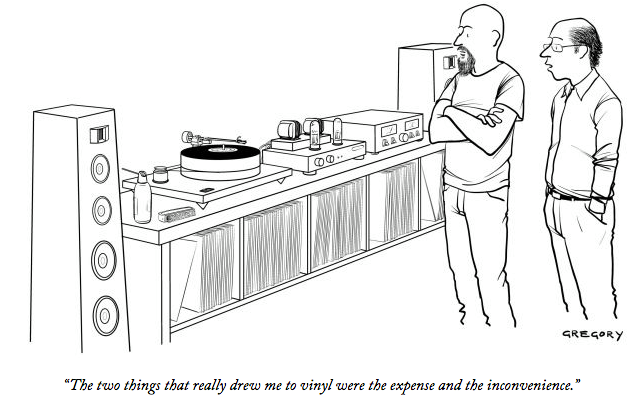
But they’re worth it
If you have a decent turntable, cartridge, pre-amp, amplifier and well positioned stereo speakers then a good record sounds incredible.
Playing Michael Jackson’s Thriller (1982) on vinyl reminded me how good a record can sound. It sounded the best that I’d ever heard it. Bad (1987) also sounds fantastic. From that moment I was hooked. I’ve been chasing good sounding records since.
I’ve heard people say, “buy albums in the dominant format of their release”. It’s been my experience that music from the 1970s and 1980s sounds best on vinyl. I’ve discovered I really like artists such as Dire Straits, Fleetwood Mac and Cat Stevens when listening to their music on vinyl.
Some music needs to be heard on vinyl. Drums, acoustic guitars and bass sound great. I never had a strong reaction to Kraftwerk until I bought The Man-Machine on vinyl. The music was alive! The sounds affected me in the same way the ring of a church bell affects me. Bliss!
Here are my tips on how to get into and experience great sounding records. I’ll explain the best ways I’ve found to keep your records and stylus clean and talk about limitations of vinyl to help you make better decisions when buying records.
Buying a turntable
Don’t go cheap. The more you spend on your turntable and cartridge the better your experience will be. Cheap turntables come with cheap cartridges and won’t reveal the most from the groove of your records. A cheap cartridge can ruin your record’s grooves and is more likely to skip.
You can upgrade some turntable components easily: cartridge, platter. After upgrading these, the performance of your turntable will be limited by the components that are harder to upgrade: plinth, tonearm and motor.
Buy a turntable that accepts the cartridge you want to use, has stable speeds, low noise and is known to track well. Watch this video.
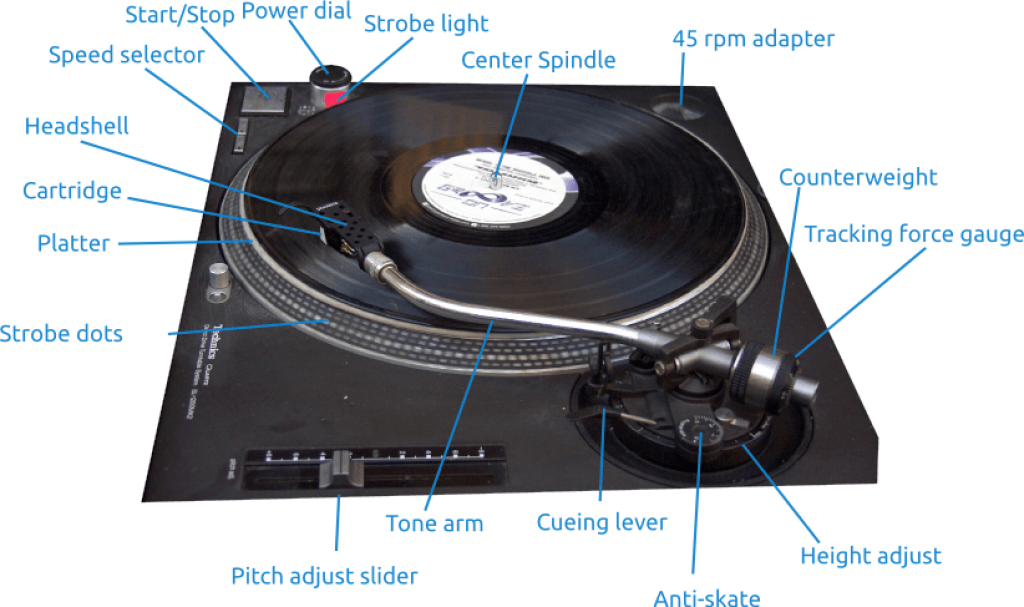
Image from: https://stereochoice.com/basic-components-of-record-player/
Records aren’t cheap. If you find you like playing records, crate digging and building your record collection, you will soon have spent more money on records than your turntable. I regret not paying a little more for a Rega Planar 3 instead of the Planar 1 that I bought at the time.
Buying speakers
You need two speakers
Don’t use a single speaker. You will miss out on the joy of two-channel audio coming from well positioned speakers. Hearing sounds separated into the left and right speaker involves you more than a single speaker. The distance makes stereo imaging stand out more than listening with headphones.
When shopping for speakers, use reviews, but trust your ears. Visit HiFi stores and audition speakers. When I was shopping for an active speaker (amplifier inside), I played lossless audio files (FLAC) via Bluetooth through the speakers I was auditioning. Playing music at full quality showed me how good a speaker could be. Music streamed through Spotify is compressed. You won’t be hearing a speaker at its best. The better your speakers (or headphones) the more you hear the loss of quality in compressed music. HiFi stores will be happy to audition speakers with a great sounding lossless source in a listening room with good acoustics.
Speaker placement
Speaker placement and room treatment make a massive difference to sound. Excellent speakers placed poorly in a room with bad acoustics sound worse than average speakers placed well in a treated room.
As a general guide your speakers should form an equal triangle with your listening position for good stereo imaging. Your speaker’s tweeters should be at ear level. If you have the space (I don’t), your speakers should not have anything between them like a TV. They should have equal space either side. They should be isolated so their vibrations don’t affect your turntable or other components.
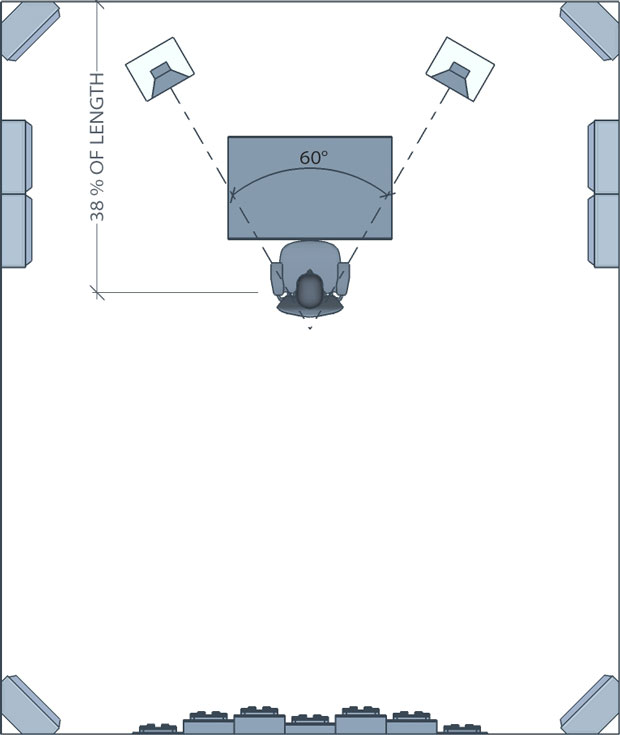
For room treatment try to reduce too much echo (reflection). Clap and listen to the echo produced. If there’s a lot, your room will benefit from adding material to absorb sound. Furniture, curtains, cushions and rugs absorb sound and can help make a room sound better. Too much absorption however and your mids and high frequencies will disappear.
Buying a pre-amplifier and amplifier
Some turntables have a built-in pre-amplifier which means you only need an amplifier. Having a separate pre-amp gives you the option to upgrade that later for improved sound.
I opted for the space-saving option of active (amp inside) bookshelf speakers. I plan on upgrading to an external amplifier and speakers when I can afford to, and have the space.
Upgrading a new or second-hand turntable
The best way to improve the sound from a turntable is to upgrade the cartridge.
Your sound preferences should influence your cartridge choice.
Some people love a warm sound. I love clarity. Ortofon are known for accurate reproduction of sound, so their cartridges match my preference.
A stylus that fills more of the groove gives you better frequency response (especially high frequencies) and traces better.
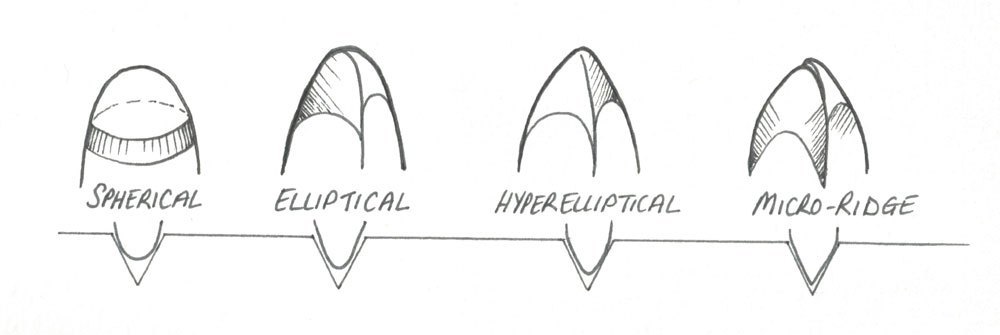
I started with a Rega Carbon – good, upgraded to a Rega Bias 2 – worse. Borrowed a friend’s Ortofon 2M Red – better. I finished on an Ortofon 2M Bronze with an elliptical stylus – great!
This upgrade unlocked more detail from my records. A record that sounded veiled now sounded great using the 2M Bronze.
Buying records
Not all records sound good
One way to find out if a record sounds good is to read Discogs user reviews. Not every record has reviews, but popular releases usually do.
Discogs is a free service. It is a great way to catalogue your collection. It shows you the value of your records (and CDs, tapes). You can create lists from your collection. I use lists to keep track of records that need a clean, records that sound great, records I want to sell, and records I want to replace (they skip or have lots of surface noise). You can buy and sell music, which is how they make money. Here’s my Discogs profile.
Discogs have a great guide to record collecting.
Dynamic Range
A great resource for helping you choose between buying a CD or record is the Dynamic Range Database. Dynamic range is the difference between the loudest and softest moments in a piece of music.
Since 1994 music has been made louder.
Loud music sounds worse and can be fatiguing.
When I play a CD released before 1994 in my car I can turn it up to 10, and it sounds great. I recently bought The Offspring – Ixnay on the Hombre (1997) CD. When I play it in my car, the loudest volume I can listen to it is 7 – which is LOUD. At 7 I can only listen to a few songs before I start feeling fatigued due to relentlessness of the sound!
Records usually have better dynamic range than CDs. Look up your favourite album using the Dynamic Range Database and you should notice the vinyl version has the better average dynamic range. Higher numbers = more dynamic range.

Buying new records
- Before buying, check Discogs user reviews.
New records have a barcode you can scan using the Discogs app if you’re in a store. This brings you straight to the release where you can select user reviews. - For a record to sound good, the recording’s source matters.
If a record is cut from analog tape, it usually sounds great. A digital source can sound good if mastered well for vinyl but it’s not a given. - New releases disappear from stores. Buy them while you can. Especially less popular artists. Stores may only order a few so you may not see it again in store.
I’ve missed out on releases by not buying them when I first saw them. Now they’re only available from third-party sellers. And much more expensive. - Records bought in store are rarely warped.
Paying a bit more in a shop is worth the peace of mind of knowing the record will be flat.
I live in Australia. It gets very hot in the summer. Shipping records from overseas while either location is very hot means I have received many warped records. When buying online is much cheaper it can be worth buying when the weather is mild in both places. Records are a pain. - Packaging. New records often come in cheap paper sleeves. Paper sleeves create static. Your records stick to the paper which can scuff your records as you pull them out. I often find records in paper sleeves are dirty and already scuffed when I pull them out.
Buy quality anti-static inner sleeves for your records. If a record comes in paper I rip off the paper and throw it away. Quality releases will usually come in anti-static inner sleeves. - Clean new and second-hand records. It’s common to get a new record that’s dirty. The best way to prevent dust/debris on your stylus is to not play dirty records in the first place.
- Choosing between coloured and black vinyl.
When I have the choice I prefer black. Carbon black is added to the PVC to make them more durable. You can also easily see the groove and dust on a black record making them easier to clean.
I care most about how records sound. It’s not common, but surface noise can sometimes be heard on coloured records. Most of my single colour and split coloured records don’t have surface noise. The one that does is half teal, half black. It also sounds muddy so bad quality all round. I don’t own any picture discs. I’ve read they are more likely to have problems with surface noise. Glow in the dark records are very likely to have surface noise. If colour or picture discs are your thing, use Discogs reviews to find out if the release you want has issues with surface noise.
Buying second-hand records
A great pleasure of record collecting is visiting record stores and flipping through records. This triggers memories and associations about the music you’re browsing.
- Ask to check the condition (at the counter).
When I started visiting record stores I would take records out of their sleeves and was told off by one shop owner. I’ve never had a problem asking to see the condition at the counter. Asking lets you check it’s the correct record too. I’ve brought home an incorrect record before. It’s good if the store has bright white lighting so you can clearly see the condition. It’s also better to hold the record in your own hands so you can make it catch the light to see scratches and spindle marks. - If you find something you’re interested in while browsing, hold onto it. You can always put it back. Avoid the disappointment of someone grabbing it while you’re busy browsing.
- When buying second-hand records online, check buyer reviews of the seller. You want to see buyer feedback like: they accurately grade their records, they package them well. Look for absence of this feedback too. If a seller grades a record accurately (or conservatively) I’ll mention it in my review so other buyers can be confident in their grading.
How to assess the condition of second-hand records
Bad
- Spindle hole marks – lots of spindle marks can indicate a careless owner. Spindle marks occur when a record is carelessly plonked in the direction of the spindle instead of carefully positioned over the spindle. This tip was told to me by the owner of my local record store.
I’ve found spindle marks correlate with scratches and surface noise.
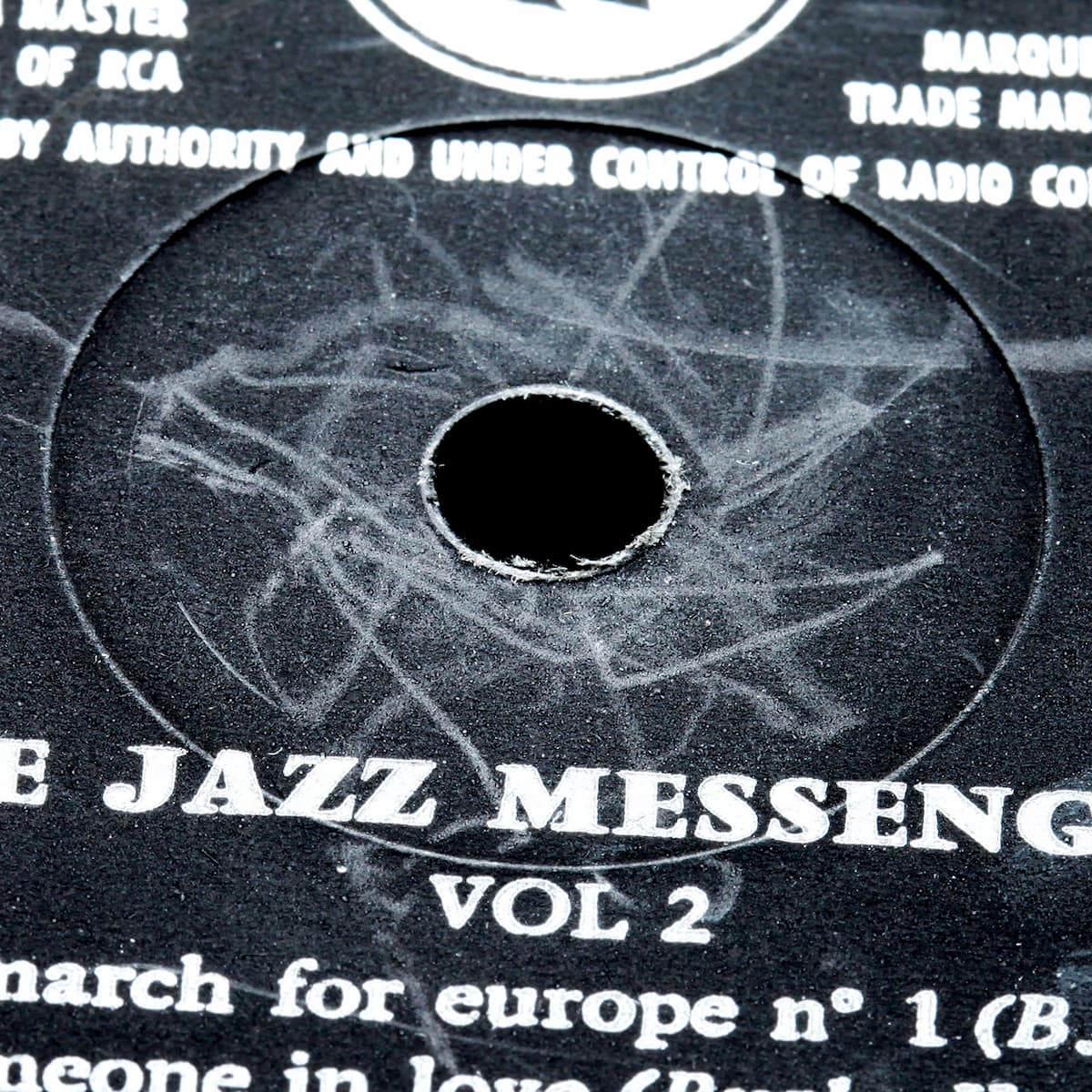
- Lots of scuffs
When I have brought home excessively scuffed/scratched records they usually have lots of clicks and pops. When it’s a loud album, you only really hear the noise in quieter parts.
I don’t buy spoken word albums anymore on vinyl. I find the surface noise distracting. - Excessive dust
An excessively dusty record is not easy to restore – with affordable cleaning methods – and indicates incorrect storage. Clicks and pops can remain even after a good clean. - Gunk (sticky dust)
Don’t play dirty records. But definitely don’t play a gunky record. Gunk will stick to your stylus attracting even more dust. Your records will sound muffled if your stylus is dirty. You will need to buy cleaning fluid to get the sticky gunk off your stylus. Don’t play wet records either. This creates gunk in the grooves of a dirty record. - Warps
Small warps will play fine. Cartridges have suspension to allow for differences in record height caused by warps.
I’ve had slight warps straighten when placed in my vertical collection.
Okay
- A few scuffs are fine, deep scratches are not.
Deep scratches will cause your stylus to skip. Scuffs won’t.
Good
- Plastic inner sleeves
Records in plastic inner sleeves are often in great condition. Plastic inner sleeves were standard in the late 70s and 80s. Today, plastic sleeves may only come with high quality pressings. - Jacket is in good condition
If the record jacket is in good condition, the record will usually be in good condition too. That’s been my experience.
Maintenance
A great tip I learnt from a Dire Straits record: your sleeve should be positioned in your record jacket with the open end at the top.
This forms a seal where dust is harder to find its way onto your record.
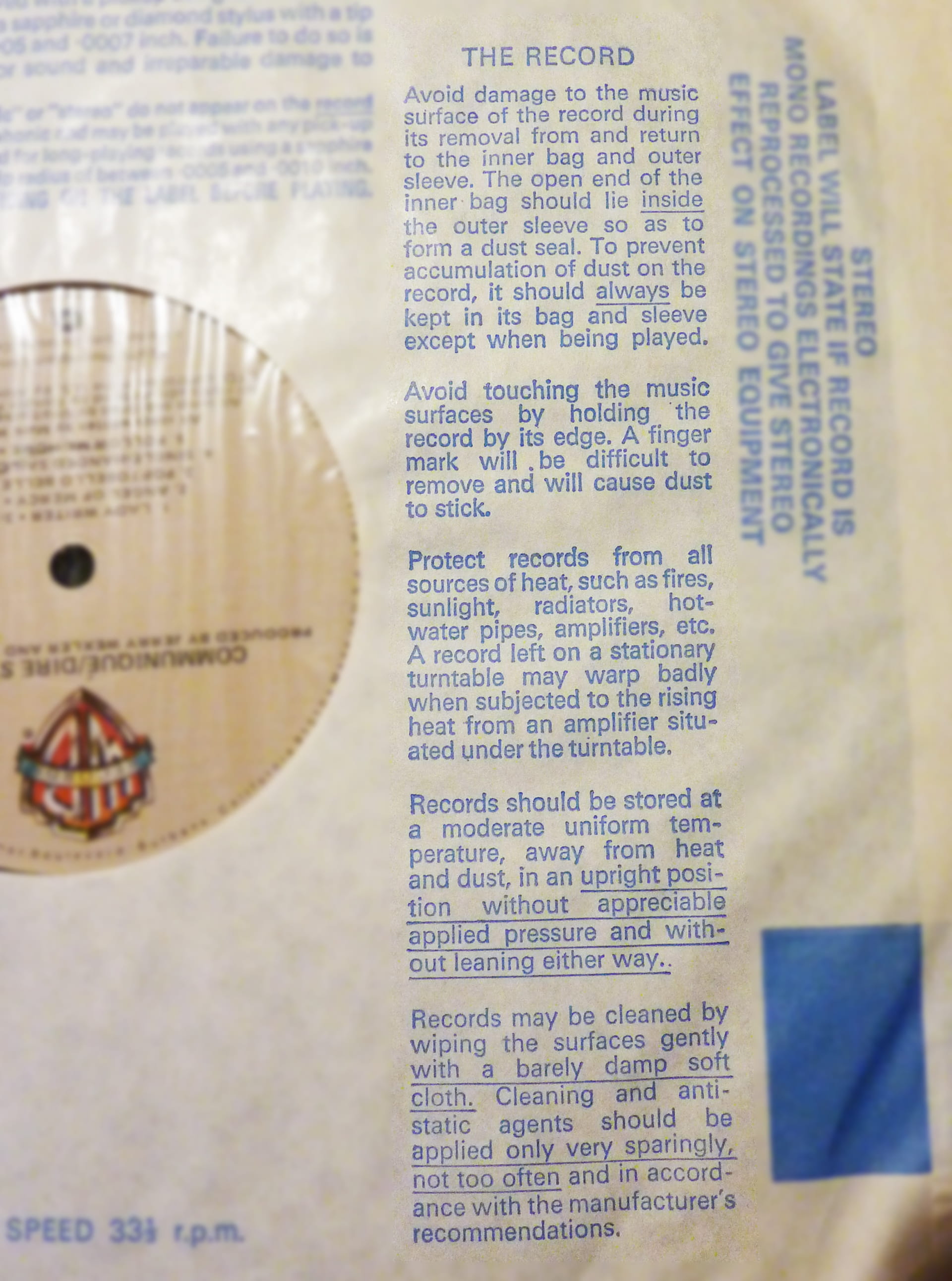
Here’s the full sleeve. Excellent advice!
Henry Rollins On Prolonging The Life Of A Vinyl Record
Accessories
I own every accessory I recommend.
Cleaning
- Project Spin Clean – affordable record cleaning system (requires fluid repurchase when you run out). (video)
I first tried a cheap mix of isopropyl alcohol, distilled water and a drip of dishwasher fluid in a spray bottle + microfibre cloths. That works okay but the Spin Clean does a much better job. - Pen microscope – get up close to see dust or gunk on your stylus
- GrooveWasher stylus cleaner – clean gunk or dirt from your stylus.
If you have never cleaned your stylus you should get an immediate improvement in sound quality after cleaning it. - LED light – use while cleaning and playing
Set-up
- Tracking force gauge – allows you to adjust the weight (tracking force) of your cartridge.
If you find many of your records are skipping, increasing the tracking force may help. - Level – ensure your turntable is level to prevent mistracking, stressing your turntable’s platter and producing unbalanced sound from the stylus hitting one groove wall more than the other.
Protection
- Quality inner sleeves
- Cover protectors
My favourite 12″ cover protectors linked above. They are crystal clear. Album artwork looks great in them. They are acid and lignin free. They are tighter fitting than the cloudy plastic outers most record stores use, making them easier to put in and pull out of a shelf. - Keep your records cool and dry
An ideal temperature is between 18°C (65°F) and 21°C (70°F), and 45% to 50% humidity. Be careful when bringing records home that you do not leave them in a hot place as they can warp. - Store your records vertically
Avoid placing records on top of each-other as this can cause them to warp and leave ring wear on the cover artwork. Enough weight can also crack your records. - Hold a record by its outer edges
Never touch a record’s groove. This transfers your body oil onto the surface attracting dust causing clicks and pops. - Gently place a record into its sleeve and jacket
Dropping them can cause sleeves and jackets to split. You might notice the bottom center of your innersleeve jacket has a split if you drop your records. When posting, sellers often take records out of their jacket to avoid jacket splitting in transit.
Limitations of vinyl records
Songs on the outer edge of a record sound better than songs on the inner edge. There is more vinyl per second on the larger outer edge.
Imagine pouring glue onto the outer edge a record. Then pouring glue into the inner edge. Once dried lifting them off and placing them in a straight line you would see the outer groove is longer.
Both play at the same speed but more sound information can be stored in the outer groove. More sound information = better sound.
Outer groove
|_-=*-_–***-_=_—++==++==_**-__-**++-==__|
Inner groove
|_-*-_-*-_=_-+=+=_*-_-*+-=_|
This is one reason why singles are often positioned as the first or second song on an album. It’s why softer songs are put on the end of a side.
Here’s Fleetwood Mac – Rumours for a visual example of the difference between the first and last songs on side A.
Bass uses more space than treble. Albums with lots of bass are often pressed onto two LPs. If your rap/hip-hop/soul/dnb album has many songs and is pressed onto one LP, it will likely sound flat. To fit it onto one record, bass and volume need to be reduced during mastering.
Artists and labels who value how music sounds on vinyl will often press an album onto two LPs. Given the choice between the same album on one or two LPs, the one pressed on two will usually sound better as there’s more space for the sound information. A good sign is lots of blank space around the record label.
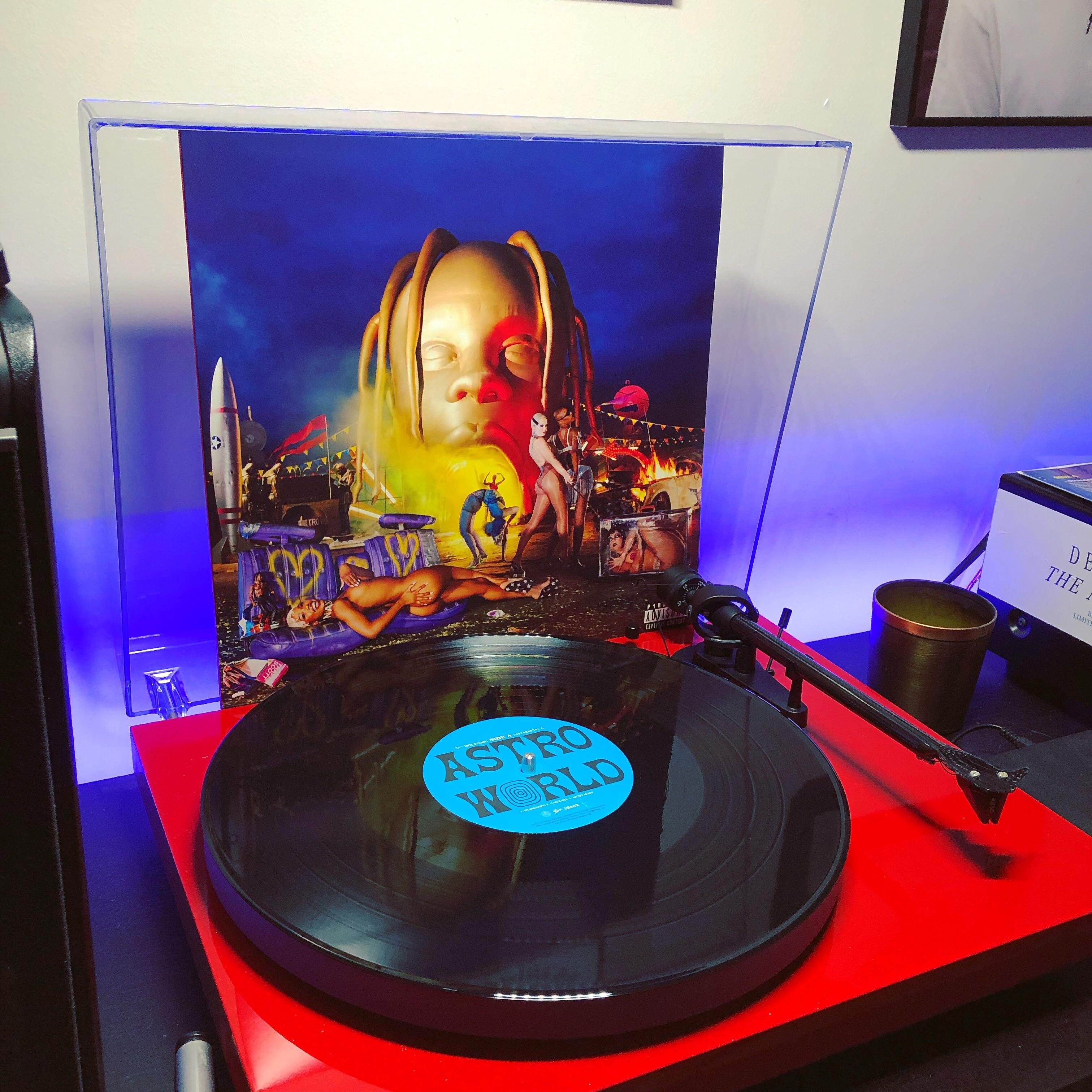
photo by u/kamikozi321 via reddit
My best sounding records
https://www.discogs.com/lists/My-best-sounding-records/599036
Resources
Here’s a good list of videos, articles and podcast episodes. They helped improve my understanding and are the source of many tips in this post.
- Episode 796: A Beginner’s Guide to Vinyl – The Ongoing History of New Music Podcast
- All About Turntables in 2019 – new or vintage? – YouTube video
- Kevin Gray on disc mastering in the digital era – Steve Hoffman forum post
- Ep086: Bernie Grundman & The Art of Record Mastering – The Vinyl Guide Podcast
- Ep042: Record Mastering 101 with Cameron Henry from Welcome to 1979 – The Vinyl Guide Podcast
- Speaker Placement Image is Everything – Nordost
- ‘Dynamic Range’ & the Loudness War – Article
- Dynamic Range Database – Database
- How Does Your Color Vinyl Sound? – VP of Sales and Marketing of Gotta Groove Records ranks colours from quietest to noisiest based on twenty years of experience.

